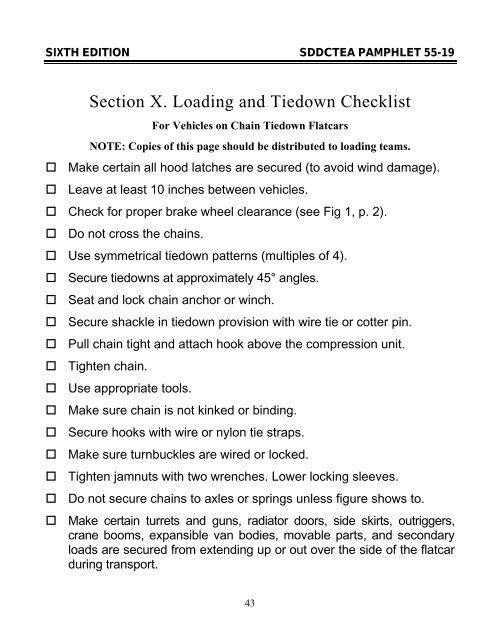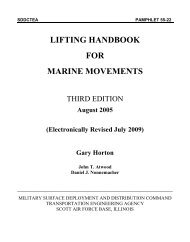Tiedown Handbook For Rail Movements - SDDCTEA - U.S. Army
Tiedown Handbook For Rail Movements - SDDCTEA - U.S. Army
Tiedown Handbook For Rail Movements - SDDCTEA - U.S. Army
You also want an ePaper? Increase the reach of your titles
YUMPU automatically turns print PDFs into web optimized ePapers that Google loves.
SIXTH EDITION <strong>SDDCTEA</strong> PAMPHLET 55-19<br />
Section X. Loading and <strong>Tiedown</strong> Checklist<br />
<strong>For</strong> Vehicles on Chain <strong>Tiedown</strong> Flatcars<br />
NOTE: Copies of this page should be distributed to loading teams.<br />
Make certain all hood latches are secured (to avoid wind damage).<br />
Leave at least 10 inches between vehicles.<br />
Check for proper brake wheel clearance (see Fig 1, p. 2).<br />
Do not cross the chains.<br />
Use symmetrical tiedown patterns (multiples of 4).<br />
Secure tiedowns at approximately 45° angles.<br />
Seat and lock chain anchor or winch.<br />
Secure shackle in tiedown provision with wire tie or cotter pin.<br />
Pull chain tight and attach hook above the compression unit.<br />
Tighten chain.<br />
Use appropriate tools.<br />
Make sure chain is not kinked or binding.<br />
Secure hooks with wire or nylon tie straps.<br />
Make sure turnbuckles are wired or locked.<br />
Tighten jamnuts with two wrenches. Lower locking sleeves.<br />
Do not secure chains to axles or springs unless figure shows to.<br />
Make certain turrets and guns, radiator doors, side skirts, outriggers,<br />
crane booms, expansible van bodies, movable parts, and secondary<br />
loads are secured from extending up or out over the side of the flatcar<br />
during transport.<br />
43




